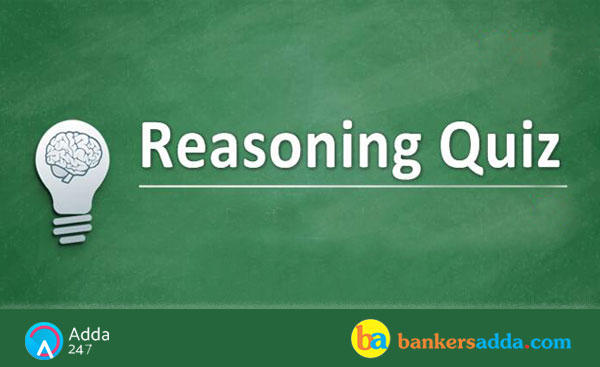Dear IBPS Clerk Aspirants,
Reasoning Ability is an onerous section. With the increasing complexity of questions, it becomes hard for one to give it the cold shoulder. The only way to make the grade in this particular section in the forthcoming banking exams is to practice continuously with all your heart and soul. And, to let you practice with the best of the latest pattern questions, here is the Adda247 Night Reasoning Quiz based on the exact same pattern of questions that are being asked in the exams.
Directions (1-5): Study the following information and answer the questions.
Seven students, namely L, M, N, O, X, Q and R, like different colour, namely Red, Blue, Pink, White, Yellow, Cream and Violet, but not necessarily in the same order. Each student also has a presentation on topics of different subjects, namely Hindi, Math, Science, Computer, Chemistry, Physics and Sanskrit but not necessarily in the same order.
Q has a presentation on Hindi and likes neither Pink nor White. The one who likes Red has a presentation on Math. L likes Blue and has a presentation neither on Computer nor on Chemistry. The one who likes Violet has a presentation on Sanskrit. M has a presentation on Physics and does not like White. The one who likes White does not have a presentation on Chemistry. O likes Yellow. R does not have a presentation on Math and does not like White. X does not like White.
Q1. On which of the following subjects does X have a presentation?
(a) Chemistry
(b) Science
(c) Sanskrit
(d) Maths
(e) Computer
Q2. Four of the following five form a group as per the given arrangement. Which of the following does not belong to that group?
(a) R – Violet
(b) Q – Cream
(c) N – White
(d) X – Blue
(e) M – Pink
Q3. Which of the following combinations is definitely correct?
(a) L – Science
(b) R – Math
(c) N – Chemistry
(d) All the given combinations are definitely correct
(e) X – Computer
Q4. Which of the following combinations of colour and subject is definitely correct with respect to N?
(a) White – Chemistry
(b) Other than those given as options
(c) Cream – Computer
(d) Red – Math
(e) White – Computer
Q5. Four of the following five form a group as per the given arrangement. Which of the following does not belong to that group?
(a) Sanskrit – Violet
(b) Science – Pink
(c) Hindi – Cream
(d) Chemistry – Yellow
(e) Computer – White
Direction(6-10).Study the following information carefully and answer the questions which follow—
In a certain code,
‘ze lo ka gi’ is a code for ‘she save some food’,
fe ka so ni’ is a code for ‘he made good food’,
‘ni lo da so’ is a code for ‘he she be good’ and
‘we so ze da’ is a code for ‘be good save grace’.
6. ‘grace be food’, may be coded as ____?
(a) ka da fe
(b) we ka so
(c) ja da we
(d) ka we da
(e) ja ka ze
7.What is the code for ‘some’?
(a) gi
(b) lo
(c) ze
(d) ka
(e) Cannot be determined
8.What does the ‘so’ stand for?
(a) good
(b) save
(c) grace
(d) be
(e) Cannot be determined
9.What is the code for ‘she’?
(a) da
(b) lo
(c) sa
(d) ni
(e) Cannot be determined
10.What is the code for ‘grace’?
(a) ze
(b) da
(c) so
(d) we
(e) None of these
Directions (11-15): In each of the following questions assuming the given statements to be true, find which of the four conclusions I, II, III and IV given below them is/are definitely true and give your answer accordingly.
11.Statements: R < K > D = V < M
Conclusions: I. R < D
II. V < R
III. D = M
IV. M > D
(a) None is true
(b) Only III is true
(c) Only IV is true
(d) Only either III or IV is true
(e) Only either III or IV and II are true
12.Statements: F > N > W < Y < T
Conclusions: I. F > W
II. T > N
III. N > Y
IV. T > W
(a) Only I and III are true
(b) Only I and IV are true
(c) Only II and III are true
(d) Only I, II and IV are true
(e) None of these
13.Statements: B > T < R > F = K
Conclusions: I. B > R
II. F < T
III. R > K
IV. K < T
(a) None is true
(b) Only I is true
(c) Only II is true
(d) Only III is true
(e) Only IV is true
14.Statements: J = F < N > H > G
Conclusions: I. G < N
II. N > J
III. H < J
IV. J < G
(a) Only I and II are true
(b) Only I, II and III are true
(c) Only II, III and IV are true
(d) All I, II, III and I are true
(e) None of these
15.Statements: D < T = R > M > K
Conclusions: I. R = D
II. R > D
III. K < T
IV. M < T
(a) Only either I or II is true
(b) Only III and IV are true
(c) Only either I or II and III are true
(d) Only either I or II and IV are true
(e) None of these



 Reasoning Quiz For Bank Foundation 2024 ...
Reasoning Quiz For Bank Foundation 2024 ...
 Reasoning Quiz For Bank Foundation 2024 ...
Reasoning Quiz For Bank Foundation 2024 ...



